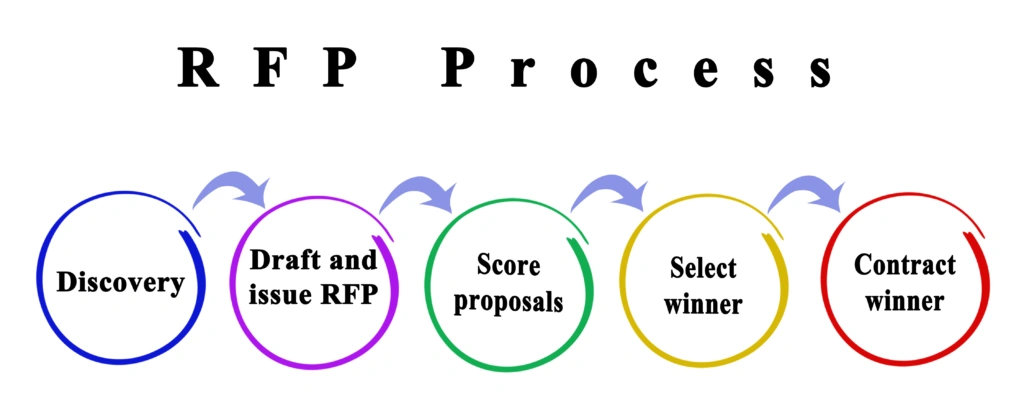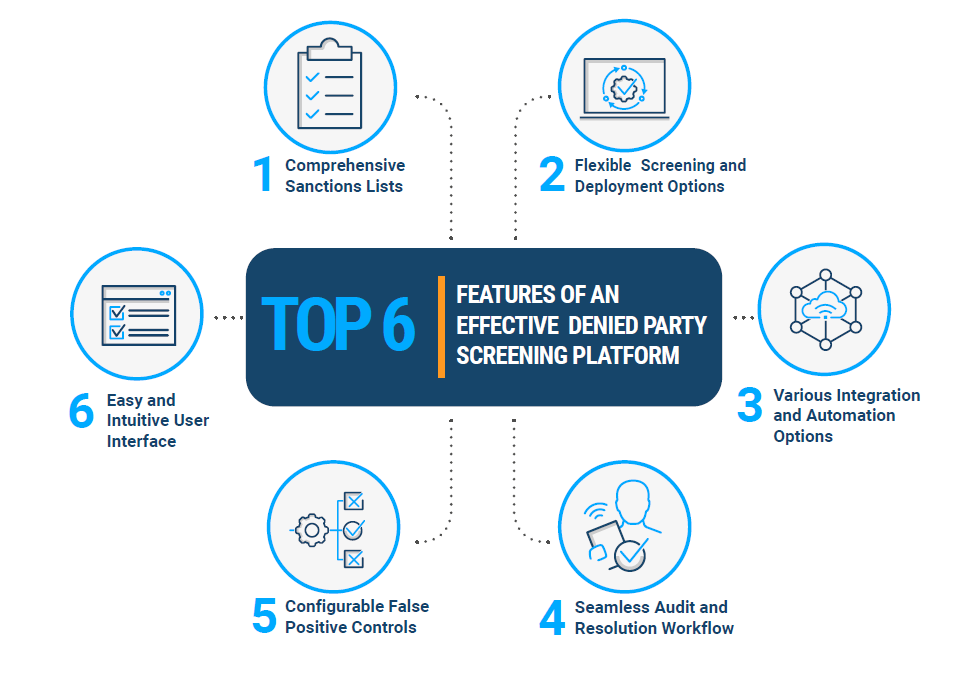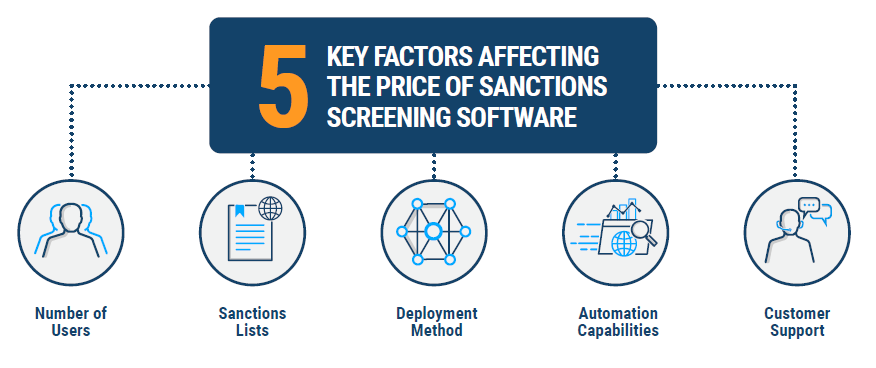In an ideal scenario, a Request for Proposal (RFP) for denied party screening software should result in just the right amount of well-thought-out responses that you can review with your team to select the right vendor. However, the traditional RFP procurement process rarely produces such straightforward optimal results.
Many times, they underperform from both the buyer and the responding vendor’s perspective. RFPs are often based on flawed assumptions, with RFP creators believing vendors are eager for their business without properly defining the desired outcomes while RFP responders prioritize the lowest price and undermine the value to be delivered.
Poorly structured RFPs are more common than not. It is not uncommon to hear of companies who have sought assistance with resolving failed denied party screening software implementation projects that originated from an RFP process. Given the important role that sanctions compliance plays in an organization, it is critical that any request for proposal (RFP) process in the area of denied party screening software should be done effectively. The risks are significant as the organization dealing with the consequences of an ensemble of mismatched services and low-value purchases that can result in operational inefficiency and sanctions violations.
In this article, we take you through the process of creating a well-structured request for proposal and share guidelines to putting together an RFP that is optimized, result-focused, practical, and efficient. We also provide helpful resources that should enable you find a best-in-class denied party screening solution and vendor who will deliver meaningful outcomes that align with your business objectives.
Key Takeaways
- RFPs when structured correctly can be a valuable tool in finding an effective denied party screening solution, however, many ‘Request for Proposal’ processes fall short of the mark.
- Not properly accounting for the complexity of denied party screening or sanctions compliance can lead to ineffective solutions that waste time, resources, and put your business at risk.
- Focusing on the business objectives and compliance challenges you want to solve will empower you to ask the right questions.
- Evaluating vendors and taking a consultative approach before sending RFPs for denied party screening software results in better qualified responses.
- Leverage industry expertise and knowledge resources to better define and identify the solution you need.
The pitfalls of traditional RFPs for Denied Party Screening Solution
A fundamental flaw in the traditional approach to the Request for Proposal (RFP) process lies in the focus on pricing and timelines rather than business outcomes, setting the stage for misaligned incentives from the outset. This misalignment often leads to sanction compliance software projects that either falter or fail altogether.

Figure 1: The Typical Request for Proposal Process
One misconception buyer’s have is that vendors are clamoring for their business and as such may not take the time to properly articulate their needs in the RFPs they prepare. When you send off RFPs, you set the rules. Any vagueness creates an opportunity for vendors to respond in such a way that either exploit loopholes that require future change orders or generates proposals for solutions that will result in problems appearing after starting the denied party screening software implementation, leading to missed deadlines, increasing costs and occasionally outright failures.
Here are the top 5 reasons why an RFP for Denied Party Screening software may fail:
- Inadequate requirements depth and breadth: Crafting RFPs for Denied Party Screening Software implementation is challenging due to the rapidly evolving nature of sanctions and regulatory compliance landscape. Your RFP should reflect the expectation that this volatility may affect you and as such give room for potential vendors to demonstrate how their solutions can help you stay ahead of the waves of regulatory change. However, most RFPs are written with strict controls on the entire scope of the project with very little flexibility. This can lock you into a contract where you get a solution that doesn’t fit the reality of your business environment, or you are stuck in the implementation phase incurring cost overruns. Additionally, you miss out on one of the biggest advantages that first-rate denied party screening vendors provide – strategy and expertise to help your solution reflect current industry best practices and meet business needs as they crop up.
- Feature focused rather than problem focused: while the technology driving the denied party screening software is important, it does not solve operational or compliance problems on its own and is merely a means by which to get things done. Simply having a list of features that can be checked on the RFP is not adequate; you need to know how their functionality will be applied to best meet your unique.

Figure 2: Features of a Best-in-Class Denied Party Screening Solution
If your RFP brief is too focused on features, comparing vendors by this metric may not reveal who will effectively support your top business objectives.
- Making pricing the main selection criteria: while having a benchmark of what a solution could cost is important for budgetary reasons, making pricing the main evaluation criteria signals to vendors that this is essentially an RFP bidding war which typically invites responses with quotes that are severely undercut in the hopes of winning the contract. On the other hand, if price is requested in a poorly defined RFP, top vendors rarely respond to such RFPs as it dilutes their differentiation and undermines the value they bring. Considering how resource and time-intensive responding to RFPs are this reaction is not surprising. Read this article to get an idea of what denied party screening software cost for various business sizes and screening volumes.
- Undermining client-vendor relationships: Often times, due to the constraints imposed by the RFP process, the prospective buyer refrains from engaging in any form of conversation with the vendor or permitting consultative dialogue. This deprives the client valuable insight that can be derived from experienced vendors, especially those fully focused on denied party screening and trade compliance. Additionally, you lose the opportunity to gauge soft features like responsiveness, trustworthiness, and compatibility.
- Sending RFPs to too many vendors: An RFP should not be carried out by simply opening it to a wide range of vendors and hoping only the very qualified few will respond. More importantly, if your RFP is advertised publicly, it says to the prospects that there is competition, and competition brings out a win-at-all-cost mentality that does not work in your favor. Ideally, requests should only be sent to denied party screening vendors you can imagine providing you with successful solutions and from whom you’d actually want to engage with.
Rethinking the RFP Approach for Denied Party Screening Software
Instead of traditional RFPs, which are drafted in a vacuum, often lacking the right level of expertise to define solution requirements, we recommend embarking on this exercise with a pre-selected list of vendors. Our long history and experience in this space has shown us that it is far more valuable to opt for a more personalized approach that seeks insight from a handful of carefully selected pool of industry experts so you can attract genuine responses from qualified vendors.
Following the guidelines provided below you can reframe your approach to RFPs.
Pre-select the Right Vendors for Denied Party Screening RFPs
Prioritize identifying knowledgeable and specialized compliance partners who understand your business challenges and demonstrate compatibility during initial discussions. Start by putting a shortlist of less than 10 denied party screening solutions providers whose work is mainly in sanctions / trade compliance. Also look to see that they have experience with companies in your industry, and check that they are appropriate-sized firms for you. Third-party reviews and independent research can play a crucial role in discovering vendors whose solutions align well with your specific use case. B2B software review platforms like G2 and Capterra offer valuable information about a vendor’s product performance, reliability, features, and overall suitability for different business needs. By analyzing multiple reviews, you can learn from real-world examples and firsthand accounts of a product’s strengths and limitations and gain a more comprehensive understanding of the solution.
Once you have prepared your initial list, approach them before sending the RFP to establish a relationship and communicate interest. Based on these interactions, cut down your list to the 5 you feel most comfortable with that can meet your needs. Then share the RFP.
Emphasize value-based selection criteria
1. Stability and Financial Performance – validate the vendor’s viability. Your denied party screening solutions provider is a partner you want to hold on to for the long term. Ensuring they can follow you on this journey is essential.
2. Business Focus – is denied party screening and trade compliance a core strategic focus? Have they committed enough resources to R&D to ensure that they are continuously innovating and consistently delivering solutions that align with ever evolving changes in the sanctions compliance field.
3. Service Quality and Customer Relations – Specifically look at customer churn, on average how long do their customer relationships last? What is the size and profile of their customer base? What is the general sentiment from existing users? Look at independent 3rd party reports and user review platforms like Capterra and G2 for additional insight.
4. Support services – do they provide frequent and relevant training? Do they have easy to access knowledge centers, organize periodic webinars, and provide additional resources as part of their service offering to help you get the most out of your investment?
5. Industry Reputation – Does the organization have industry awards and recognition relevant to denied party screening?
Explore this article for detailed checklist on how to effectively evaluate solutions and potential vendor partners.
Be Open to Speaking with Potential Vendor Partners
Potential partners that are interested in responding to your RFP will most likely reach out, have an open communication channel that allows for better collaboration. If you are working with a pre-selected list as recommended in the section above, then there are only a handful of people you will be dealing it. These will take much less time and resources than having to wade through tons of suboptimal RFP responses.
Avoid Price-Centric Directives
Keep pricing requests at an ‘order-of-magnitude’ level, particularly if your core requirements are still being determined. Focus instead on articulating business challenges to engage vendors in meaningful discussions. Get a good sense of factors that influence pricing and measure how important those factors are to overall business objectives.

Figure 3: Key Factors That Influence the Price of Denied Party Screening Software
For more insights on how to achieve an efficient cost to value balance, use our pricing miniguide which explains the relevance of these factors for different types of organizations.
Focus On Articulating Business Challenges
Your RFP should essentially be a “Request for Solution’. Rather than have prospective vendors answer questions solely on features and technical specifications of their denied party screening software. Let the responses be geared towards how they can help your organization achieve the compliance performance it desires. Ensure to identify the challenges that are critical for you to fix. Knowing what your goals are will get you better responses and improve your chances of finding a long-term strategic partner. It will also transform your sanctions compliance program into a growth lever.
Listed below are some of the ways business objectives can be achieved successfully when properly aligned and supported by a denied party screening program.
1. Drive sales velocity and cut down on wasted efforts by proactively screening prospects at each stage of the sales cycles.
2. Build resilience and facilitate strategic process by integrating denied party screening into other core functions.
3. Improve client experience and prevent revenue loss by increasing accuracy of screening results to minimize false positives that result in delayed onboarding / denial of service.
4. Facilitate entry into new markets and fast-evolving areas by providing clarity on regulatory compliance expectations.
5. Foster collaboration and prevent the fragmentation of compliance culture across the organization. Vendors should be able to demonstrate how their platforms support collaborative workflows, operational efficiency, and consistent compliance screening.
To help you properly craft an RFP or RFS that reflects your business goals, check out our popular buyer’s guide for denied party screening.
Meet Your Trade Compliance Needs with Descartes Highly Rated Denied Party Screening Software
We understand that selecting the right denied party screening software is not just about sanctions compliance, it is about empowering the entire organization to proactively manage risk, enhance efficiency, support business growth, and ultimately achieve regulatory excellence.
That is why a core tenet at Descartes is to thoroughly understand your business goals to ensure we provide solutions that foster true strategic partnerships and long-term relationships. Descartes Visual Compliance and Descartes MK Denied Party Screening solutions are flexible and modular, allowing organizations to pick the specific and exact functionality and content they require for their particular compliance needs and scale up later as and when necessary.
Our denied party screening software was recently listed among the top 50 Best software by G2, an online third-party business software review platform. We were the only denied party screening solution to make the top 50 list. This recognition was driven largely by the testimonials of real and verified users of the Descartes Denied Party Screening software. We were also rated as leaders across several key performance metrics in our software category including Best Usability, Easiest Setup, Best Relationship, Best Results, and Highest User Adoption.
If you would like to explore Descartes’ industry-leading suite of denied party screening, 3rd party risk management solutions, and trade content solutions, please contact us.
You can read more of what our customers are saying about Descartes Denied Party Screening on G2



